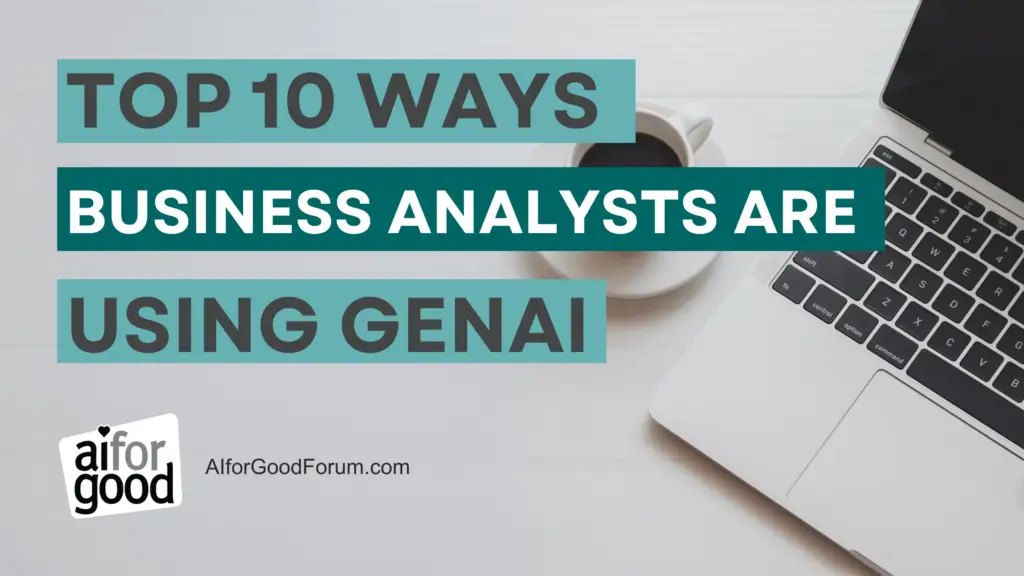Have you ever wondered how Business Analysts leverage AI to gather data, optimize workflows, and recommend strategic solutions? Drawing on insights from Anthropic’s new Economic Index—based on anonymized user data from Claude.ai—AI for Good Forum showcases how today’s Business Analysts (traditionally known as Management Analysts) are turning to AI to tackle complex organizational challenges.
Check out our last article on how marketing managers are using AI in real use cases.
Top 10 Ways Business Analysts Are Using AI
-
Information Gathering & Organization
AI tools automate data collection and sort through vast sets of documents, spreadsheets, and internal communications—helping analysts quickly identify core issues and opportunities.
✅ Example: Prompt ChatGPT to categorize feedback from customer support tickets, highlighting the most common problem areas.
-
Data Analysis & Solution Development
From data cleansing to pattern detection, AI transforms raw information into actionable insights. Analysts can then develop data-driven solutions and alternative processes.
✅ Example: Use Claude to review KPI dashboards, suggest improvement strategies, and simulate potential outcomes of each approach.
-
Stakeholder Collaboration & System Integration
Business Analysts must work with diverse teams. AI streamlines communication by providing real-time summaries of meetings, project statuses, and newly implemented procedures.
✅ Example: Integrate an AI note-taker into virtual meetings to auto-generate action items and follow-up tasks for cross-functional teams.
-
Records Management & Compliance
Creating and maintaining organized records is crucial for smooth operations. AI can handle the classification, retrieval, and protection of documents in compliance with organizational policies.
✅ Example: Prompt an AI document management system to identify outdated files and flag those requiring immediate archiving or secure disposal.
-
Process Review & Improvement
AI can quickly evaluate forms, reports, and workflows, identifying inefficiencies or redundancies. Analysts can then propose targeted upgrades for processes that truly matter.
✅ Example: Use an AI-driven process mining tool to visualize bottlenecks in your approval workflows and recommend simpler procedures.
-
On-Site Observations & Interviews
While AI can’t replace the human touch of direct interviews, it offers structured interview guides and real-time transcription, making it easier to gather, interpret, and share findings.
✅ Example: Have Microsoft Copilot generate an interview questionnaire for employees affected by a recent software migration.
-
Documenting Findings & Recommendations
Business Analysts often compile results of their studies into formal reports. AI drafting tools accelerate this process, ensuring clarity, consistency, and actionable next steps.
✅ Example: Ask ChatGPT to draft an executive summary for a reorganization proposal, summarizing key data points and recommended changes.
-
Manual Creation & Worker Training
By analyzing best practices and user feedback, AI can help craft user-friendly manuals and training materials, enabling smooth adoption of new systems and procedures.
✅ Example: Use Claude to create a training module for newly implemented reporting tools, complete with step-by-step visuals and interactive quizzes.
-
Forms & Report Design
Redundant or confusing forms can derail productivity. AI assists in designing intuitive interfaces, ensuring that key data is captured while streamlining end-user experience.
✅ Example: Prompt an AI-based form builder to simplify a multi-page expense report, consolidating fields and adding auto-fill suggestions.
-
Strategic Planning & Cost Analysis
Whether it’s inventory control or organizational change, AI-driven analytics give Business Analysts deeper insights into cost-saving measures and sustainable operational improvements.
✅ Example: Have an AI cost-analysis tool project the ROI of implementing a new inventory management system compared to the status quo.
Why More Business Analysts Need to Embrace AI
Business Analysts who integrate AI are better equipped to uncover hidden trends, propose more accurate solutions, and expedite the decision-making process. By offloading repetitive tasks to AI, analysts can devote more energy to strategic thinking, relationship building, and guiding teams through transformative change.
Try This Business Analyst AI Prompt!
“Act as a process consultant. Review our current workflow for handling client onboarding. Identify two bottlenecks and propose streamlined procedures or tools to address them—include cost estimates and a rollout timeline.”
Want more Business Analyst-specific AI prompts?
Request access to our exclusive AI Prompt Library!

